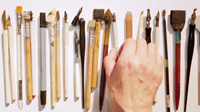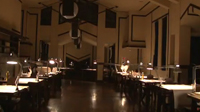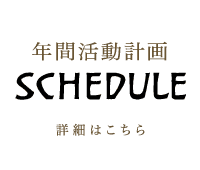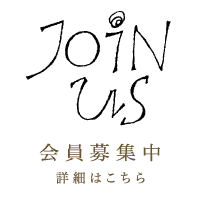» ゴードン恵美「レターカッティング・ワークショップ2019」 開催概要
» ゴードン恵美「レターカッティング・ワークショップ2019」 レポート
ワークショップレポート
昨秋に開催されました、ゴードン恵美レターカッティングワークショップに参加された方よりレポートが届きました。
東京からはこの度初参加の中野豊さん、神戸からは初回より毎回参加の米谷明香さんです。
<東京会場参加 中野豊>
2019年11月2日(土)~4日(月)に東京の江東区文化センターにて開催された『ゴードン恵美「レターカッティング入門ワークショップ」2019』に参加した。
自分にとっては、やっと参加することができた、という気持ちだ。
というのは、このワークショプのことを知ったのは、約10年前に自分がまだ美術大学生の頃で、一緒にタイポグラフィを学んでいたクラスメイトからこのワークショップに参加したことを聞いたことから始まる。その頃は、文字=紙に印字するもの、そしてこれからのインターネット社会でどうデザイナーは文字を扱っていくのかという問題を勉強する真面目な学生であった。そして、ワークショップのことを聞いて「文字を石に彫るなんて古代人みたい」という軽い衝撃を受けたのを覚えている。しかし、その時はそれほど深くワークショップのことを聞くことはなく、時は経ち、大学を卒業し、グラフィックデザイナーとなった。
しかし、「文字を石に彫る」というワードは、忘れた頃にふと思い出すことがあり、ついに今年、たまたま、思い出して検索したタイミングにワークショップ開催の情報を見つけ、参加することに決めた。日々の業務の中、コンピューター上で扱う文字たちから離れて、感触のある文字と向き合いたいと思ったのである。
「さあ彫るぞ」と意気込んだものの、いきなり彫れるわけはなく、まず彫るデザインを決めなくてはならない。3日間のワークショップが開催される前から、月一回某所で行われている『石彫会』内で行われるクリティーク(講評会)に参加して、人の意見を聞きながらデザインを詰めていく。これは恵美さんが修行したイギリスの工房での経験から始めたという。
クリティーク初日、そもそもクリティーク会がどういうものか、どういう人たちがいるのか、同業者のデザイナーたちが集まっているのではないか、文字を研究する気難しい人がいるのではないか、張り詰めた空気の中、難しいことを討論し合っているのではないか・・・そんな様々な妄想で不安になりながら、会場へ向かった。着いた会場では、参加者がお菓子をつまみながら談笑しており、穏やかな空気で、ひとまず安心。卓上のイーゼルに石板を固定して、カンカンと石を彫っている人もいる。
自分は初参加だったので、今回はガイダンスを兼ねて、クリティークに手ぶらで参加した。
自分以外の参加者はほとんどワークショップの経験者とのことだった。
クリティークが始まると、黒板に各自のデザインを貼り、そのデザインのコンセプトや経緯をプレゼンしていく。すると、先ほど穏やかに談笑していた参加者が黒板の前に移動し、発表者のデザインをじっくり凝視し、字間や行間のスペースや文字のフォルムや構図について意見を述べていく。後に聞くと、参加者の職業は専業主婦や音楽関係の方、外資系企業に勤務する人など様々。デザイナーの人もいるが殆ど他業種とのこと。「これは怖い!」。文字に関わる職業の人ならわかるが、普段文字を扱う仕事ではない人たちが適確に指摘をしていく。普段の自分の仕事もここまで見られているのかと思うと、背中にじっとりとした汗が出るのを感じる。
クリティークでは意見を述べるのも、発表する順番も挙手制。日本の「右に倣え」の教育で育ってきた自分には結構辛い。
こんな世界があるのかと、衝撃を受けつつ、適当にやるわけにはいかない。真面目にやらなければと、気持ちが引き締まった。そもそも、なぜこんなクリティーク会をワークショップ開催の3ヶ月前からやるのか尋ねたところ、限られた3日間のワークショップの時間節約でもあるが、石を彫るまでの工程を大切にしているとのこと。そして次の言葉にどきりとした「石は自分が死んだ後も残る」。紙は歴史的に重要性がない限りそれほど長くは残らないであろう、コンピューターに関しては、あるのかないのかさえよくわからない状態であり、何かあれば一瞬でなくなってしまう。そのため、簡単に石には彫らず、彫るまでに準備を重ねてデザインを詰めていくそうである。
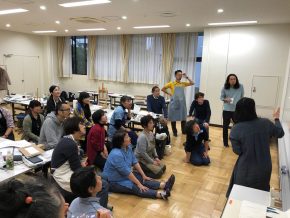
2回目のクリティーク。やはり前回のようにそれぞれのプレゼンに容赦なく(?)コメントが飛び交う。勇気をだして「エイ!」と手を挙げ、デザイン画というより、手書きのアイデアの羅列をホワイトボードに貼り、色々と突っ込まれないようにそそくさとプレゼン。自分の選んだ単語は2歳になる息子の名前「光 HIKARI」。正方形のプレートに、HIKARIを輪っか状にしたり、オールドローマン体での頭文字「H」を表記したりしたもの等。その中に、石には伝統的で厳格な古典的スタイルの文字を彫るものという思い込みがあり、奇抜なものは邪道とされるのではないかという恐れから、いちばんのお気に入りではあったが発表するのに躊躇した案があった。ローマン体表記のHIKARIのエレメントを抽出し、漢字「光」を構成したアイデア。勇気を出して参加者に見せてみると意外に好評で、拍子抜けした。
どれでいくか迷っていたが、みんなが背中を押してくれ、その漢字「光」のアイデアで進める自信を持つことができた。
3回目のクリティークでは、デザインのベースとなる書体の検証。活字の見本帳から当初探っていたが、結局、自分のPCに入っているデジタルフォントを使うことに。それをPCのグラフィックソフトで切り貼りする。当初からのアイデアである、「TRAJAN」をはじめ、「Baskerville」「Caslon」「Cochin」「Palatino」「Bodoni」等、自分なりに好きな書体、エレメントが綺麗なものをあら選びする。やはり「TRAJAN」は美しく、気品があり、安定感があるが、息子っぽいかというとそうでもなく、ヤンチャで走り回り、お菓子の大好きなうちの子には「Bodoni」の『R』のストロークくらい勢いがあってポップな方がふさわしいのではないかと思えてくる。そんなことをクリティークで発表。構造は同じだが書体によって様々に表情が変わることを参加者はおもしろがってくれ。ほっとした。
ここで、恵美さんへメールで現状報告。経験者の話を聞くと、恵美さんとは何回もキャッチボールしながら修正と再提出を繰り返すと聞き、どんなダメ出しをされるか粗を指摘されるか、もしくは全否定されるのではないかと緊張しながら送信。数日後に恵美さんから返信が。特に粗を指摘されることもなく、アイデアをおもしろがってくれた。引き続き、ワークショップ当日までに手書きでブラッシュアップすることに。
ワークショップ当日。何個も検証を重ねて完成度を上げたいと思っていたが、結局、時間が取れず、焦りながら、朝方に勢いで書き上げた。そしてそのまま、電車に飛び乗り会場へ。若干遅刻して到着すると、恵美さん指導の元、机のレイアウト替えを行なっていた。そこに初心者、経験者、ベテラン組とバランスよく練られたチームに分かれて着席。そして改まって、自己紹介。皆さんの話を聞いていると「前回のワークショップでデザインを決めてから6年間、石を彫る練習しています」や「数年間石の裏側を彫って練習しています」とおっしゃる方がちらほら。そして多くの参加者が「今回こそ仕上げたいです」とのコメントを。なんだか先がとてつもなく遠くに感じてクラクラして来た。
自己紹介が一通り終わって、教室の端に先生の作品や、経験者の作品が置かれて、参考に眺めさせてもらう。どの作品もとっても綺麗に彫られていて、自分も早く彫ってみたいという衝動にかられる。

しかし、そう簡単に石を彫りだすことはできない。初参加チームは石を渡されて、その石を丁寧に磨くことから始まる。部屋に隅にあるシンクで紙鑢を使って、ひたすら水研ぎをする。
渡された時の表面はデコボコしており、角は鋭くトゲトゲしている。しかし、磨きを終えた見本の石を見ると、表面は真っ平らで、角も綺麗に面取りしており、硬いはずの石を柔らかく感じるほどである。そんな石を目指して、石を磨く。最初は慣れない動きで疲れ、背中の痛みを感じたが、だんだん石の表面がツルツルになっていくと楽しくなってきて、無心なっていく。度々、デザインが決定していない人達のクリティークが始まり、その都度、手を休めて参加する。そこでも、各文字の字間、行間、フォルム、セリフの先端の処理に至るところまで、意見が飛び交う。「やはり恐ろしい…」。恵美さんはちゃんと誰の発言かをチェックしていて、全員がコメントをするようにする。そのため、気を抜いて別のことを考えていられない。何か言わなければと頭をフル回転させることに。クリティークが終われば、また無心に石磨き。これを何セットもくりかえす。
そして、自分の最終段階の手書きのデザインも発表する。すると「人が走っているように見える」など様々な意見や感想が飛び交い、照れて顔がにやけてしまう。ただ、そこで、「光」の横のストロークの両端の処理の仕方に疑問を寄せられた。横のストロークは「H」の横ストロークから抽出しているが、両端の形状は見えないので、想像で描かなければならない。
参考にローマン体の書体の「-」などの約物で確認したがはっきりわからず創作していたら、いつの間にか明朝体の鱗のような習字の筆で書いたような形状になっていた。ただ、カリグラフィーのペンでの動きはそれとは違っているとのことで、若干そこが気になるという。確かにどこかちぐはぐしているように思えてきて、ペンでの動きを教えてもらい、再びブラッシュアップすることに。そして再び、石磨きの続き。ここで1日目は終了。
2日目。石磨きで軽い筋肉痛になっている。石磨きは仕上げの一番目の細かいヤスリで磨いて終了。磨く前と比べると明らかに、手にしっくり馴染むようになった。彫ってしまうのが勿体ないとすら思ってしまう。なんだか、一仕事終えたようで気持ちがいい。石磨きは心を浄化する作用があるようだ。
自分の石はちょうど層になっていて、雨風に打たれていると割れてしまうらしい。その代わり、石磨きをしていたら、金色に輝く層が出てきた。石の方向も彫るデザインに合わせて考えなければならない。決してコントロールできない偶然性と人工物である文字との対話が魅力的である。
石を乾かしながら、デザインを見直して詰める。横のストロークの端の処理、長さ、石に対しての大きさを検証する。ペンと修正液を使い、削ったり足したり、それをコピーしてきては切り貼りして調節する。それをさらにコピーを取ってきてまた調節。自分の納得のいったところで、またクリティーク。色々、検証したことを発表したのちに、デザインはこれでいくとみんなの前で断言。結局は自分が納得いくか、どうしたいかが重要だと思った。参加者の皆さんは拍手をしてくれた。ような気がする。
そして次のステップに。決まったデザインに合わせて、チズル(石を彫るノミ)を選ぶ。自分のデザインは細い線から太い線まで線の太さの幅があるため、結局、小・中・大の3本を購入。大抵の人は1本で足りることが多いらしい。そしてダミー(ハンマー)も。早く、彫ってみたいという衝動にかられる。が、しかし、これまたそう簡単には彫ることはできない。今度は道具を準備しなければならない。購入したばかりのチズルはそのままでは使えない。アルミ板に貼り付けられたダイヤモンドのヤスリで研ぐ。石をヤスリで磨き、タングステンをダイヤモンドで研ぐ。普段の生活ではなかなか経験できない作業が新鮮で、実に楽しい。淡々とした簡単な作業が、作品の完成度をだんだんと上げていっているようで、彫ってもいないのに、自分の作品も完成度が上がっていっているように感じてしまう。
しかし2日目はそこで終了。懇親会のため、新宿へ移動。恵美さんや石彫会の皆さんと仕事や普段の生活や子供の話をしてリフレッシュ。
3日目。昨日完成したデザインをどういう配置で正方形の石に置くかを考える。偶然にも石を磨いていたら出てきた金の層との関係もある。ふと、正方形の石を45度回転させて角が下に来るように配置してみる。収まりがいい。これで行こうと決めて、ついに石を彫る時が来たかと思いきや今度は石を保護するため、カバーを透明のポリプロピレンフィルムで製作する。天とサイド4面をカットしテープでつなげて作る。作りは簡単だが、持ち運ぶ時に石を傷から守ってくれる。
さらに、石に下書きするための白い水性色鉛筆を削る。石に負担をかけないため(?)、普段色鉛筆として使う時と比べて、かなり芯を長く鋭利に削る。美大受験の予備校でデッサン用の鉛筆もそうやって削らされていたことを思い出す。石彫りまで着々と進んでいる。そして次はデザインを彫る前に裏側にキーホール(=壁にかけるため、フックを架けるための金具)を取り付けるための凹みを彫らなければならない。恵美さんが彫り方の見本を見せてくれた。参加者の中にはこのキーホール用の凹みを何年も彫っていた方もいるようで、今回はデザインを数年かけてやっと彫るに至ったらしいが、スムーズに綺麗に彫ることができ、このワークショップ中に作品を彫りあげていた。凹みを作る作業だが石を彫るいい練習になるようだ。
ようやく、実際に石を彫ってみる時がきた。まずはチズルの持ち方、そしてそのチズルをダミーで叩く。チズルは衝撃が伝わるように親指をかけずに軽く握る。これまで経験したどの道具とも扱い方が違い、慣れるまで、随分と練習と経験が必要だと感じた。何年もキーホールの溝を彫っている人や、石の裏にもう彫るところがなくなるほど彫る練習をしている人たちの理由がわかった気がする。
まずは小さな正方形をダイヤモンド状に彫るという基本的技法を実際に彫ってみる。中心が一番深くなるように、正方形を対角線で4等分した4つの三角形をそれぞれ面に平行になるように彫っていく。うまく、対角線が直線になるように、中心がズレないよう。慎重にちょっとずつ。基本、石は方向を変えられないので、石は動かさず、彫る人間が動いて、手首のひねりで彫る方向を調節するそうだ。恵美さんが最初に見本を見せてくれたが簡単に彫っていく。早速自分で彫ってみようとすると、体勢が決まらず、気づくとチズルの握り方が誤っていたり、体が硬ってしまったりして、うまく彫れない。「あーもっと練習したい」と思ったところで終了。
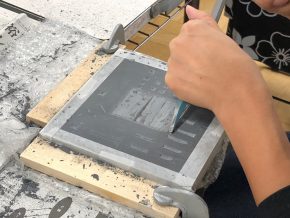
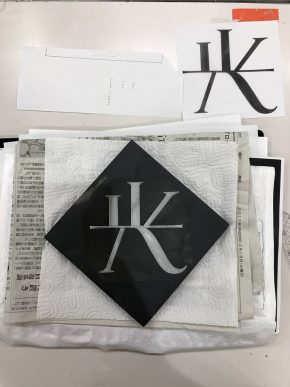
このワークショップ及び、クリティーク会は忘れかけていた、学生の頃、学んでいたタイポグラフィの文字に対する姿勢を呼び起こしてくれた。そして、同業者ではなくても、こんなに文字に対して実直に向き合う人たちがいるということを知り、身が引き締まる思いだった。
結局「石彫り」までにはワークショップ中にはたどり着けなかったが、「石彫り道」のスタートラインに立つことはできたかと思う。コツコツと「石彫会」に参加して自主練と石彫りの先輩達に指南してもらいながらコツコツと彫っていこうと思う。
<神戸会場参加 米谷明香>
レターカッティングのワークショップは初めて開催された2009年から毎回参加しています。最初のワークショップで受けた衝撃と楽しさが忘れられず、継続して受講して今回で7回目になりました。
ワークショップはクリティークの時間とそれぞれの石彫りの技術を学ぶ時間の2つを交互にすすんでいきます。
まずはクリティークから。ワークショップでいちばん楽しく、そのために毎回受けてしまうといってもいい時間です。今回私は新しくデザインしなかったので自分自身は発表することはなかったのですが、いつもと同じく本当に刺激的で豊かな時間でした。
それぞれが考えてきた石に彫るデザインについて全員で意見を交わします。なぜその言葉や書体を選んだのか、どのような経過をたどって今の段階にたどりついたのか。デザインとともにその方自身を少し知ることのできる時間で、その後意見を述べるときに割合これが大事な気がします。ちょっと間があってぽつぽつと始まるやり取り。文字そのものの形、スペーシング、レイアウトの位置、いくつか作ったなかでどれがよいのか。時折講師の恵美さんから「○○はどう思う?」などさらに考えるための声が絶妙な間で。まず他の人に語ることで自分の現状を把握し、そして他の参加者とやり取りし多様な視点に触れてどう修正するのか判断していきます。大切なのは、「あの人がこういったからこうする」ではなく、自分がどうしていきたいか、それに近づくにはどうしたらよいのか深く考えること。
ちょっとした違和感を詰めていって、レイアウトの位置をほんの少し動かすことでガラッと変わるのを目の当たりにすると、ふだんこれだけしつこく取り組めていないことに思い至ります。
ふだん私はひとりで考えて判断することが多く、当然嗜好にも偏りがあり「自分の範囲」が狭いので、クリティークで他の方のデザインに触れること、そして多様な指摘・見方をきき、ひとつひとつ自分はどう思うのかを考えることは本当に勉強になります。長く参加していると、自分自身にも変化があり以前と重視することが変わっているのを感じることもあります。今回印象に残ったことのひとつは「その人らしさ」を残す、ということ。ドローイングなので修正を重ねていわゆる「正しい」文字にしていくこともできるけれど、それがクリティークの目的ではなくて、魅力的な作品にしていくためのやり取りなのだなと思いました。その人らしいよさ、というのは案外自分で気が付かないものなのかもしれません。
デザインを考えるうえで、石ならではと感じたのは、レイアウトの調整が少し停滞したように思えた時に恵美さんから出た、石の向きを変えたらどうかという提案。結果的にそれがとてもしっくりいって、そういう方向からの変更にはっとしました。また、紙とちがって石は厚みがあるので、余白のことを考える際にそれを考慮にいれて最後に石の上で調整すること。彫る経験を積んでいくと、それがはっきりとイメージできるようになるのだろうと思います。スライドショーの時に見た恵美さんの石に直接描かれた下書きの線と彫られた奥行と柔らかさのある線を見ながら、線の質についても最初からイメージできるようになりたいと思っていました。
石彫の時間はそれぞれの段階にあわせたことを教えていただくのですが、私は前回から引き続いてレリーフに取り組みました。レリーフの課題が出たときに真っ先に思い浮かんだフランス・クリュニーのロマネスク時代の神の子羊の模刻(文字の部分だけオリジナルをベースにしてデザイン)の試し彫りです。事前に、前回教わったことや、恵美さんとのメールでのやり取りで手順を確認しながら少し進めていました。これまでVカットの文字を彫ることしかしていないので、試し彫りとはいえレリーフなんて彫れるのだろうかと不安もあったのですが、彫り始めてみると前回教わった「Bead Mould」という石の縁を飾る装飾(玉縁)の彫り方(Vカットから始め、角をおとして丸くやすりをかける)がつながっていることに気が付きました。線を刻むという行為の線上に文字もレリーフも。文字を構成するのはVカットの凹部分だけですが、レリーフの場合はVカットのように線を彫りながらも凹凸両方がレリーフになることに、線から彫刻のようなものがうまれてきたときはこんな感じなのかもと勝手におもしろく感じたり。彫りながらたくさん出てきた疑問点を、ワークショップのときにはそれを恵美さんに教えていただきました。
そして今使っているのは石灰岩なので、スレートとはちがってすべてチョップで彫るほうが早くきれいに彫ることができるということ。もうひとつ石灰岩を扱うときの注意点として今回知ったのは、洗ってはいけないということ。石灰岩は吸水率が高いため、一度濡らしてしまうとなかなか乾かず、湿度の高い日本だとカビが中に生えてしまう可能性があるとのことでした。石の性質にあわせて技術や扱いを使い分ける、まだまだ奥深い世界です。
ひたすら彫りながらも、いろんな段階の方がいらっしゃるおかげで、道具や石の扱い方や基本の彫り方、文字に色をつける手順等これまでのことも改めて確認。
目で見て考える時間と手を動かす時間、この繰り返しであっというまに終了した3日間。参加するたびに文字や石に真摯に向かう気持ちを新たにしています。そしてまた次がある、と思えるしあわせ。少しずつ今の作品をすすめながら、次も変わらず参加できることを楽しみにしております。

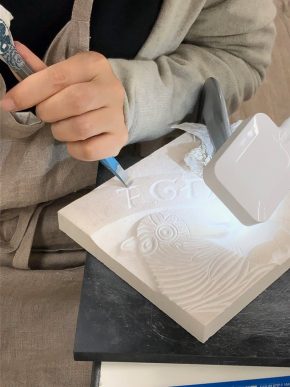
東京会場および神戸スライドレクチャー会場決定のお知らせ 2019.08.10
『ゴードン恵美「レターカッティング入門ワークショップ」2019 東京会場および神戸スライドレクチャー会場決定のお知らせ』をNewsのページにアップしました。
受付状況 2019.07.23
『ゴードン恵美「レターカッティング入門ワークショップ」2019 受付状況』をNewsのページにアップしました。
一般申込み受付けスタート 2019.06.24
『ゴードン恵美「レターカッティング入門ワークショップ」2019 一般申込み受付けスタート』をNewsのページにアップしました。
申込みをスタートします。 2019.06.17
『ゴードン恵美「レターカッティング入門ワークショップ」2019 申込みをスタートします。』をNewsのページにアップしました。
詳細・申込み要項のご案内 2019.05.16
『ゴードン恵美「レターカッティング入門ワークショップ」2019詳細・申込み要項のご案内』をNewsのページにアップしました。
開催のご案内 2019.3.20
7回目となるレターカッティングWSを、ゴードン恵美を迎えて開催いたします。
昨年は諸事情により急遽中止となり、お申込みいただいていました皆様には大変ご迷惑をおかけいたしました。
今回は東京・神戸の2会場で以下の日程で開催いたします。
東京会場:2019年11月2日(土)~4日(月・祝)
神戸会場:2019年11月8日(金)~10日(日)
それぞれ3日間コース及びスライドレクチャーを行います。
詳細及び募集要項は5月中旬にウェブサイトでお知らせする予定です。
皆さまのご参加をお待ちしています。
<ゴードン恵美プロフィール>
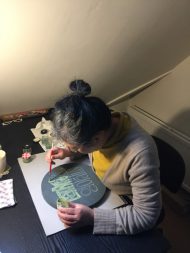 1995年にカリグラフィーを東京で習い始める。翌年、トーマス・イングマイヤー氏のワークショップを受講し海外でカリグラフィーを学ぶ事を決意。2年の準備期間を経て、97年に渡英、98年にUniversity of Surrey Roehampton のカリグラフィー・ディグリー(学位)コースに入学。2001年に卒業後、2002年にケンブリッジにあるレターカッティング工房であるカードーゾ・キンダスリー・ワークショップ(Cardozo Kindersley Workshop)に入門。2006年に長女出産のため退職するまでの4年半勤務。現在は独立し、主にレターカッティングの仕事を続ける。2002年から2004年までSSIのAdvanced Training Schemeに参加。Sue HuftonやTom Perkinsなど多数のカリグラファー、レターカッターのワークショップやレクチャーに参加。2011年よりCambridge Open Studiosで作品を展示。The Lettering Arts Trust 主催の作品展 には過去2年連続参加。2019年3月15日から5月26日に開催されるThe Lost Words - forget me not (The Lettering Arts Trust主催) の作品展にも参加。日本でのレターカッティング・ワークショップは今年で7回目の開催となる。
1995年にカリグラフィーを東京で習い始める。翌年、トーマス・イングマイヤー氏のワークショップを受講し海外でカリグラフィーを学ぶ事を決意。2年の準備期間を経て、97年に渡英、98年にUniversity of Surrey Roehampton のカリグラフィー・ディグリー(学位)コースに入学。2001年に卒業後、2002年にケンブリッジにあるレターカッティング工房であるカードーゾ・キンダスリー・ワークショップ(Cardozo Kindersley Workshop)に入門。2006年に長女出産のため退職するまでの4年半勤務。現在は独立し、主にレターカッティングの仕事を続ける。2002年から2004年までSSIのAdvanced Training Schemeに参加。Sue HuftonやTom Perkinsなど多数のカリグラファー、レターカッターのワークショップやレクチャーに参加。2011年よりCambridge Open Studiosで作品を展示。The Lettering Arts Trust 主催の作品展 には過去2年連続参加。2019年3月15日から5月26日に開催されるThe Lost Words - forget me not (The Lettering Arts Trust主催) の作品展にも参加。日本でのレターカッティング・ワークショップは今年で7回目の開催となる。
講師関連サイト
Cambridge Open Studio https://www.camopenstudios.co.uk/
Memorials by Artists http://www.memorialsbyartists.co.uk/home/
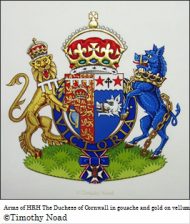
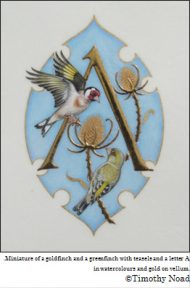
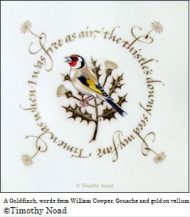
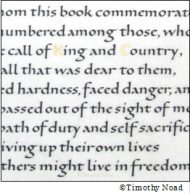
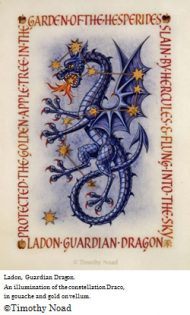
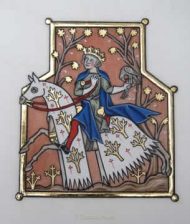
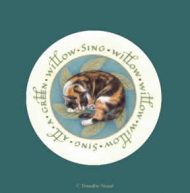
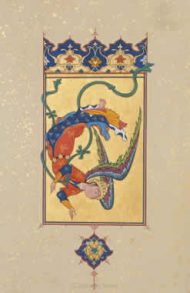
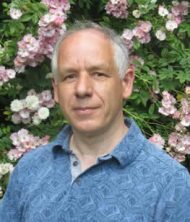

 The Art of Illuminated Letters (with Patricia Seligman 1994)
The Art of Illuminated Letters (with Patricia Seligman 1994)






